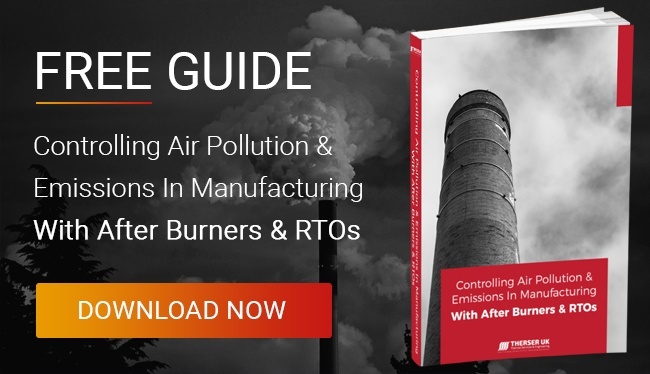Share this
What is an RTO Thermal Oxidiser and How Does it Reduce Pollution and Energy Costs?
by Therser Sales Team on 05-Oct-2023 10:33:05

Using an incinerator or thermal oxidiser to combat air pollution is undeniably effective, but it can also be quite costly. The irony lies in the fact that while these high-temperature incinerators work to control pollution, they require a significant amount of energy to power the burner itself. Typically, this energy comes from natural gas, a fossil fuel, thereby depleting valuable resources and adding to your expenses. Furthermore, this process generates exhaust that needs to be dealt with separately, creating an additional challenge.
Waste Heat Reclamation
A regenerative thermal oxidiser offers a unique solution. It not only effectively incinerates hazardous compounds from exhaust fumes but also allows for the recovery of a significant amount of waste heat, resulting in reduced costs for pollution control and energy expenditure.
The operation of an RTO system involves the absorption of heat from exhaust gases, which are typically already at high temperatures. This captured heat is then used to pre-heat and destroy pollutants in the bulk gas stream that is released from the process at elevated temperatures, usually around 900°C. By incorporating pre-treatment heat exchange towers alongside the main incineration chamber, RTO systems have proven to be highly efficient in removing 85% to 97% of airborne pollutants from exhaust waste.
At the same time, the potential for heat recapture makes an RTO far more fuel-efficient than other types of incinerator.
Basic Components Of An RTO
Regenerative thermal oxidisers come in a variety of sizes and designs to deal with different pollutants. However, they all consist of two or three heat exchangers or towers, connected by a common high temperature combustion chamber and one or more burners. Within each tower there are beds filled with heat conductive ceramic material which provides a passage for the polluted air stream, and also acts as a storage vessel for the waste heat.
Common Applications For Regenerative Thermal Oxidation
RTO units can treat a wide variety of airborne pollutants, including foul-smelling gases, particulate matter, nitrogen oxide and volatile organic compounds. These pollutants are found in waste products from many chemical and industrial processes – such as those used in the printing and packaging industry, wood processing, ceramics, glass making and other sectors.
Talk To Us
At Therser, we design, manufacture, install and maintain a range of industrial furnaces, kilns and RTOs. Our RTO units operate at elevated temperatures to achieve near total destruction of contaminants in air streams coming from furnaces and kilns. We also design bespoke pollution control systems, upgrade or retrofit existing furnaces and provide full engineering support services; including calibration, relocation and regular maintenance. To discuss your requirements with one of our team please call us on 01782 824453.
For more information about RTOs and other pollution control devices, please click here to download our free guide to Controlling Air Pollution & Emissions.
Share this
- Company News (90)
- Battery Materials (41)
- kiln (37)
- fabrication (29)
- Alloy (27)
- Furnace (27)
- Welding (16)
- Industrial Kilns (15)
- Battery (13)
- Ceramic Kilns (13)
- Processes (13)
- alloy fabrication (13)
- Shuttle Kilns (12)
- RTO’s (11)
- Vacancies (11)
- Hydrogen (10)
- Therser UK (9)
- Tunnel Kiln (9)
- Refractory (8)
- Therser (8)
- Wellman Furnaces (8)
- Brickwork (7)
- Case Studies (7)
- Afterburners (6)
- Fibre Lining (6)
- electric (6)
- Almor Wellman (5)
- thermal engineers (5)
- Biochar (4)
- Exhibition (4)
- Pyrolysis (4)
- Servicing (4)
- Spares (4)
- heat treatment (4)
- History (3)
- Ceramics Uk (2)
- Combustion Control Upgrades (2)
- Nitrogen (2)
- Temperature Control Rings (2)
- gas (2)
- Certificates (1)
- Instrumentation (1)
- MMC (1)
- RHK (1)
- Roller Hearth Kiln (1)
- Test Trials (1)
- aerospace (1)
- analyser (1)
- elec (1)
- oxygen (1)
- vans (1)
- September 2025 (2)
- May 2025 (2)
- March 2025 (1)
- February 2025 (2)
- January 2025 (5)
- December 2024 (5)
- November 2024 (7)
- October 2024 (5)
- September 2024 (4)
- August 2024 (14)
- July 2024 (13)
- June 2024 (2)
- May 2024 (5)
- April 2024 (13)
- March 2024 (8)
- February 2024 (12)
- January 2024 (14)
- December 2023 (6)
- November 2023 (12)
- October 2023 (24)
- September 2023 (11)
- August 2023 (11)
- July 2023 (9)
- June 2023 (15)
- May 2023 (53)
- April 2023 (5)
- March 2023 (6)
- February 2023 (7)
- January 2023 (3)
- December 2022 (8)
- November 2022 (5)
- October 2022 (11)
- September 2022 (1)
- August 2022 (2)
- July 2022 (1)
- June 2022 (2)
- May 2022 (1)
- March 2022 (1)
- February 2022 (1)
- January 2022 (1)
- December 2021 (3)
- October 2021 (1)
- August 2021 (1)
- June 2021 (1)
- May 2021 (4)
- April 2021 (2)
- March 2021 (4)
- February 2021 (2)
- December 2020 (3)
- November 2020 (1)
- September 2020 (3)
- May 2020 (1)
- April 2020 (2)
- March 2020 (1)
- January 2020 (1)
- December 2019 (1)
- July 2019 (2)
- June 2019 (1)
- April 2019 (2)
- March 2019 (3)
- February 2019 (4)
- December 2018 (1)
- November 2018 (1)
- September 2018 (2)
- August 2018 (1)
- July 2018 (1)
- May 2018 (3)
- April 2018 (1)
- February 2018 (3)
- January 2018 (2)
- December 2017 (3)
- November 2017 (1)
- October 2017 (2)
- September 2017 (4)
- August 2017 (1)
- July 2017 (2)
- June 2017 (2)
- May 2017 (3)
- April 2017 (3)



